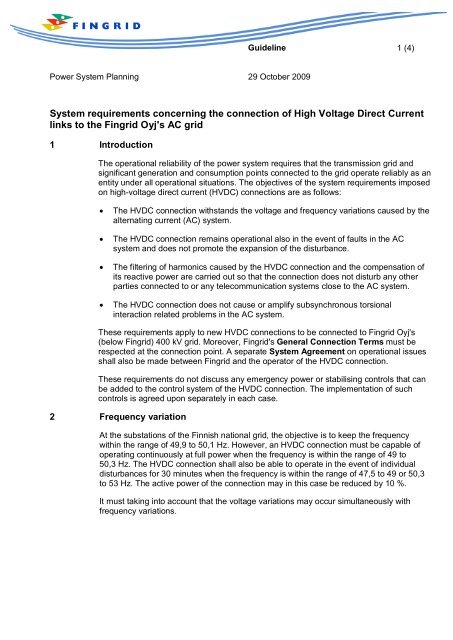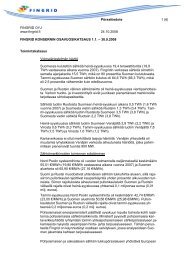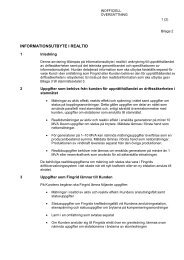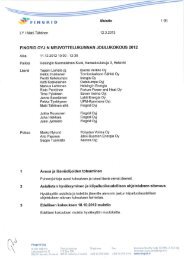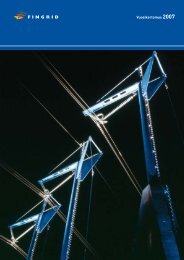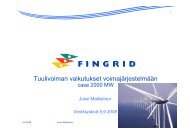HVDC system requirements - Fingrid
HVDC system requirements - Fingrid
HVDC system requirements - Fingrid
Create successful ePaper yourself
Turn your PDF publications into a flip-book with our unique Google optimized e-Paper software.
Guideline 1 (4)<br />
Power System Planning 29 October 2009<br />
System <strong>requirements</strong> concerning the connection of High Voltage Direct Current<br />
links to the <strong>Fingrid</strong> Oyj's AC grid<br />
1 Introduction<br />
The operational reliability of the power <strong>system</strong> requires that the transmission grid and<br />
significant generation and consumption points connected to the grid operate reliably as an<br />
entity under all operational situations. The objectives of the <strong>system</strong> <strong>requirements</strong> imposed<br />
on high-voltage direct current (<strong>HVDC</strong>) connections are as follows:<br />
<br />
<br />
<br />
The <strong>HVDC</strong> connection withstands the voltage and frequency variations caused by the<br />
alternating current (AC) <strong>system</strong>.<br />
The <strong>HVDC</strong> connection remains operational also in the event of faults in the AC<br />
<strong>system</strong> and does not promote the expansion of the disturbance.<br />
The filtering of harmonics caused by the <strong>HVDC</strong> connection and the compensation of<br />
its reactive power are carried out so that the connection does not disturb any other<br />
parties connected to or any telecommunication <strong>system</strong>s close to the AC <strong>system</strong>.<br />
The <strong>HVDC</strong> connection does not cause or amplify subsynchronous torsional<br />
interaction related problems in the AC <strong>system</strong>.<br />
These <strong>requirements</strong> apply to new <strong>HVDC</strong> connections to be connected to <strong>Fingrid</strong> Oyj's<br />
(below <strong>Fingrid</strong>) 400 kV grid. Moreover, <strong>Fingrid</strong>'s General Connection Terms must be<br />
respected at the connection point. A separate System Agreement on operational issues<br />
shall also be made between <strong>Fingrid</strong> and the operator of the <strong>HVDC</strong> connection.<br />
These <strong>requirements</strong> do not discuss any emergency power or stabilising controls that can<br />
be added to the control <strong>system</strong> of the <strong>HVDC</strong> connection. The implementation of such<br />
controls is agreed upon separately in each case.<br />
2 Frequency variation<br />
At the substations of the Finnish national grid, the objective is to keep the frequency<br />
within the range of 49,9 to 50,1 Hz. However, an <strong>HVDC</strong> connection must be capable of<br />
operating continuously at full power when the frequency is within the range of 49 to<br />
50,3 Hz. The <strong>HVDC</strong> connection shall also be able to operate in the event of individual<br />
disturbances for 30 minutes when the frequency is within the range of 47,5 to 49 or 50,3<br />
to 53 Hz. The active power of the connection may in this case be reduced by 10 %.<br />
It must taking into account that the voltage variations may occur simultaneously with<br />
frequency variations.
Guideline 2 (4)<br />
Power System Planning 29 October 2009<br />
3 Fault level at the connection point<br />
If the operation of the <strong>HVDC</strong> connection requires a certain minimum short circuit power<br />
from the AC grid, the fulfilment of the value in question must be verified individually at the<br />
connection point. <strong>Fingrid</strong> will specify the minimum short circuit power in the situation<br />
which most restricts the short circuit power at the connection point. This is based on the<br />
Nordic grid dimensioning rules, according to which no individual fault may lead to an<br />
expanding disturbance, in this case to the tripping of the <strong>HVDC</strong> connection.<br />
4 Properties of the AC voltage at the 400 kV connection points<br />
At the 400 kV substations of the Finnish national grid, the objective is to keep the voltage<br />
within the optimum range of 405 to 415 kV. However, an <strong>HVDC</strong> connection must be<br />
capable of operating continuously at full power when the voltage is within the range of<br />
395 to 420 kV. The <strong>HVDC</strong> connection shall also be able to operate in the event of<br />
individual disturbances for 30 minutes when the voltage is within the range of 360 to<br />
395 kV. The active power of the connection may in this case be reduced by 10 %.<br />
The 10 minute average of negative sequence component of voltage in three phase<br />
<strong>system</strong> will be below 1 %, but short time values may exceed this level.<br />
5 Properties of the AC voltage at the 220 kV connection points<br />
At the 220 kV substations of the Finnish national grid, the objective is to keep the voltage<br />
within the optimum range of 220 to 235 kV. However, an <strong>HVDC</strong> connection must be<br />
capable of operating continuously at full power when the voltage is within the range of<br />
215 to 245 kV. The <strong>HVDC</strong> connection shall also be able to operate in the event of<br />
individual disturbances for 30 minutes when the voltage is within the range of 205 to<br />
215 kV. The active power of the connection may in this case be reduced by 10%.<br />
The 10 minute average of negative sequence component of voltage in three phase<br />
<strong>system</strong> will be below 1 %, but short time values may exceed this level.<br />
6 Properties of the AC voltage at the 110 kV connection points<br />
At the 110 kV substations of the Finnish national grid, the objective is to keep the voltage<br />
within the optimum range of 110 to 122 kV. However, an <strong>HVDC</strong> connection must be<br />
capable of operating continuously at full power when the voltage is within the range of<br />
105 to 123 kV. The <strong>HVDC</strong> connection shall also be able to operate in the event of<br />
individual disturbances for 30 minutes when the voltage is within the range of 100 to<br />
105 kV.<br />
The 10 minute average of negative sequence component of voltage in three phase<br />
<strong>system</strong> will be below 2 %, but short time values may exceed this level.<br />
7 Filtering of harmonics and compensation of reactive power of the link<br />
The harmonic voltages and currents at the connection point shall not exceed the limit<br />
values given in Table 1.
Guideline 3 (4)<br />
Power System Planning 29 October 2009<br />
However, as the limit values refer to the total value of harmonics in the connection point,<br />
possible harmonic injections by other connecting parties shall also be taken into account.<br />
This will be done by <strong>Fingrid</strong> after receiving the preliminary harmonic injection values of<br />
the planned <strong>HVDC</strong> connection. For filtering studies <strong>Fingrid</strong> will give the harmonic<br />
impedance range of the connection point at all relevant harmonic frequencies. Rough<br />
estimation for background harmonic levels half of the values of table 1 can be assumed.<br />
MAXIMUM LEVELS OF HARMONIC VOLTAGES AND CURRENTS AT THE<br />
TRANSMISSION VOLTAGE LEVEL<br />
Per cent of the nominal voltage<br />
Odd<br />
Non multiple of 3 Multiple of 3<br />
Even<br />
n n n<br />
% % %<br />
5 2 3 2 2 1.5<br />
7 2 9 1 4 1<br />
11 1.5 15 0.3 6 0.5<br />
13 1.5 21 0.2 8 0.2<br />
17 1 >21 0.2 10 0.2<br />
19 1 12 0.2<br />
23 0.7 >12 0.2<br />
25 0.7<br />
>25 0.1+<br />
12.5/n<br />
Total harmonic distortion of voltage < 3%<br />
Psophometric value of phase current < 5 A<br />
Table 1 Maximum permitted harmonics including existing harmonics<br />
The filtering and reactive power compensation banks required by the <strong>HVDC</strong> connection<br />
shall be realised so that their connection does not cause a voltage change higher than<br />
3 % at the connection point (also see item 5). However, the maximum permitted reactive<br />
power generation by a single bank is normally 80 Mvar. Larger units may be used, if the<br />
conditions at the connection point it allows. Moreover, the compensation of reactive<br />
power at the connection point must be carried out so that the amount of reactive power<br />
fed into the AC grid or taken from it under normal operating conditions is reasonable,<br />
which may be at the most 8 % of the nominal power of the <strong>HVDC</strong> connection.<br />
If the <strong>HVDC</strong> connection can independently regulate its reactive power, the starting point<br />
is that part of its reactive power capability is reserved as a disturbance reserve for the AC<br />
grid in the manner specified for generators.<br />
8 Subsynchronous torsional interaction<br />
The <strong>HVDC</strong> connection shall not cause subsynchronous torsional interaction (SSTI)<br />
problems in the AC <strong>system</strong>. If necessary, the control <strong>system</strong> of the <strong>HVDC</strong> connection<br />
must be capable of damping subsynchronous resonance frequencies characteristic of<br />
turbogenerators connected to the connection point or its vicinity.
Guideline 4 (4)<br />
Power System Planning 29 October 2009<br />
The control <strong>system</strong> must also be capable of immediately disconnecting the <strong>HVDC</strong><br />
connection if the subsynchronous currents exceed the prescribed limits.<br />
9 Other technical <strong>requirements</strong><br />
The <strong>HVDC</strong> connection must be designed so that it remains operational and stays<br />
connected to the grid in a stable manner also during disturbances in the AC grid. The<br />
power of the connection must be at least 90 % of the value preceding the disturbance<br />
when 300 ms have elapsed from the tripping of a single-phase, two-phase or three-phase<br />
earth fault or short circuit in the AC grid. Faults in the 400 kV AC grid are normally<br />
disconnected in less than 0,1 seconds and within 0,5 s in 110 kV and 220 kV grids. In<br />
single-phase high-resistance faults, the fault time may extend to up to 5 seconds.<br />
Voltage stiffness at the connection point may, especially in various outage and fault<br />
situations in the AC grid, restrict the maximum permitted stepwise power changes of the<br />
<strong>HVDC</strong> connection. For this reason, it must be possible to restrict the stepwise power<br />
changes together with the related switching of filter and compensation banks so that they<br />
do not cause a voltage change in excess of 3 % at the connection point. Large filter<br />
banks must be connected with synchronised circuit breakers. The power changes must<br />
be carried out by ramp speeds agreed with <strong>Fingrid</strong>. The principles and the practical<br />
implementation of the <strong>HVDC</strong> control shall be agreed in detail individually for each<br />
connection point.<br />
The <strong>HVDC</strong> connection must not essentially increase the short circuit currents at the<br />
connection point or cause disturbingly large current and/or voltage transients to the AC<br />
grid. The zero sequence impedance of the converter transformer shall be less than<br />
100 % and the transformer must able to operate with neutral point grounded or<br />
ungrounded. Moreover the converter transformer shall be connected to grid by<br />
synchronised breaker. The <strong>HVDC</strong> protection <strong>system</strong> must be designed so that internal<br />
faults within the connection are disconnected within 100 ms from the moment when the<br />
fault was originated. If the connection trips, it must also be ensured that its filter and<br />
compensation banks are disconnected from the AC grid at the same time.<br />
10 Supply and verification of information<br />
Sufficient information on the <strong>HVDC</strong> connection shall be delivered to <strong>Fingrid</strong>. This<br />
information includes among other things data on the equipment (including filter data) and<br />
<strong>system</strong>s used in the connection, their protection <strong>system</strong>s and the operation mode of the<br />
connection. The information delivered must also include a description of the operation of<br />
the <strong>HVDC</strong> connection during various fault situations in the AC and DC <strong>system</strong>s as well as<br />
its effect on potential subsynchronous resonance conditions.<br />
The correctness of information pertaining to the <strong>HVDC</strong> connection and the fulfilment of<br />
<strong>requirements</strong> specified for the connection must be verified, as far as possible, through<br />
tests carried out in conjunction with the commissioning of the connection. The contents<br />
and other arrangements concerning the tests are to be agreed separately with <strong>Fingrid</strong>.


